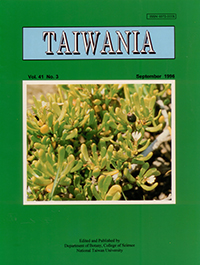Research Paper
Seasonal Patterns of Nitrogen-Fixing Ability (C2H2 Reduction) and Hydrogen Uptake by Actinorhizal Nodules of Casuarina equisetifolia Linn.
Mohammad Athar
Published on: September 1996
Page: 208 - 214
DOI: 10.6165/tai.1996.41.208
Abstract
Casuarina equisetifolia is an actinorhizal tree being introduced in agroforestry systems of Pakistan. A study was conducted to observe the seasonal changes in nodular nitrogenase activity (C2H2 reduction) and uptake hydrogenase activity of C. equisetifolia. Nodules showed significant (P SYMBOL 163 f 'Symbol' 0.05) seasonal variation in the nitrogenase and hydrogenase activities which were highest during June (13.52 SYMBOL 109 f 'Symbol' moles C2H4 . g-1 fresh nodule wt. hr-1 and 2.55 SYMBOL 109 f 'Symbol' moles H2 consumed g-1 fresh nodule wt. hr-1, respectively) and lowest during December (0.55 SYMBOL 109 f 'Symbol' moles C2H4 . g-1 fresh nodule wt. hr-1 and 0.23 SYMBOL 109 f 'Symbol' moles H2 consumed g-1 fresh nodule wt. hr-1, respectively). This study has many important and applied ecological implications in the management of horticulture and agroforestry systems of the tropics.
中文摘要
木麻黃係巴基斯坦引進的農林樹種之一種。本研究主要是觀測於季節不同時,其固氮作用及氫氣攝取的能力變化狀況。根瘤於六月份時上述兩種活性達到最高,而於十二月份時活性最低。本研究對於熱帶農林或園藝的管理於應用生態學上有多方面的重要性與參考價值。
Keyword: Casuarina, Nitrogenase, Hydrogenase, N fixation


